While Régine is on her way to South America (and certainly writing up more smart projects from Design Interactions on the plane), here’s a few highlights from some of the other departments at the Royal College’s Great Exhibition:
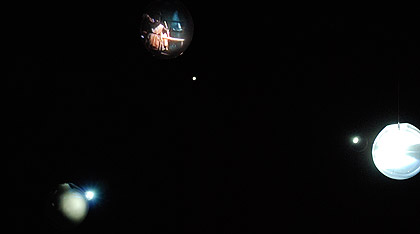 Michaela Nettell’s Bathysphere
Michaela Nettell’s Bathysphere
Some of the most amazing work came from Platform 11’s students, headed by Noam Toran (who is for example responsible for the wonderfully timeless videos of Dunne and Raby’s robots) and Carey Young.
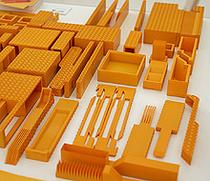
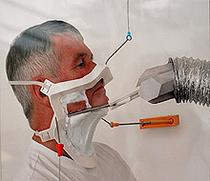 Scenes from a roboted Life
Scenes from a roboted Life
First thing I spotted was Martin Postler‘s Scenes from a roboted Life, which are tools and various adaptors (“Human body fixation clamps”) to enable robots to aid humans with everyday life such as cleaning ears, shaving or playing mikado, a bit along the lines of the japanese Robot Dispatch or Paro. However, Postler’s design has a LEGO-like playfulness and colors about it which makes the whole set a real pleasure to look at and the photos of a robot’s (big cardboard head and aluminium foil-arms) interaction with a middle-aged man are just hilarious. He also exhibited a range of DIY-guns made from paper.
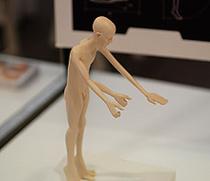
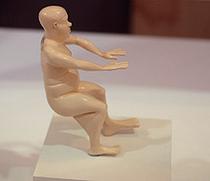 Genetically engineered sweatshop-workers
Genetically engineered sweatshop-workers
Right next to that were Jule Jenckel‘s works, most notably her models of genetically engineered sweatshop workers whose bodily features have been altered to enable them to work more efficiently in fictitious textile factories. One model for example had a re-enforced lower leg to operate a manual sewing machine while others have multiple hands etc. Another exhibited and well-known project by her is Home Sweet Home, a range of objects/products that deal with domestic violence.
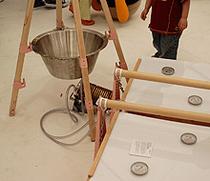
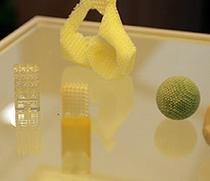 Ian Ferguson likes to cook and was exhibiting all kinds of works that evolved around food. From his “Man With a Pan” in which he tried to look at kitchen tools like a prehistoric man would (he ended up cutting meat by banging on it with the edge of a pan) to picnic-sets for post-apocalyptic scenarios in which a little steam engine can be used to still prepare meat in a sophisticated way. He also showed objects that were made to prototype porosity. On show as well was nifty jewellery grown from big crystals in various forms and Brit Leissler’s Sole on Ice which visitors could also try out in front of the tent – right next to an installation that allowed you to listen to a tree pumping water up through osmosis to sustain its life.
Ian Ferguson likes to cook and was exhibiting all kinds of works that evolved around food. From his “Man With a Pan” in which he tried to look at kitchen tools like a prehistoric man would (he ended up cutting meat by banging on it with the edge of a pan) to picnic-sets for post-apocalyptic scenarios in which a little steam engine can be used to still prepare meat in a sophisticated way. He also showed objects that were made to prototype porosity. On show as well was nifty jewellery grown from big crystals in various forms and Brit Leissler’s Sole on Ice which visitors could also try out in front of the tent – right next to an installation that allowed you to listen to a tree pumping water up through osmosis to sustain its life.
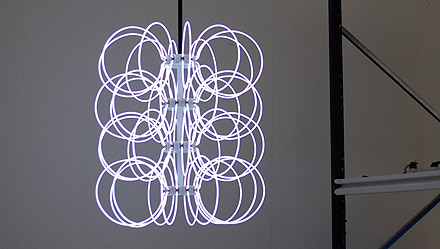
A last product design comes from Wanju Kim in the form of the gorgeous Cactus chandelier that she made from hand-bent EEFL-lamp, revealing a beauty that is usually hidden when only used as a backlight for a computer screen.

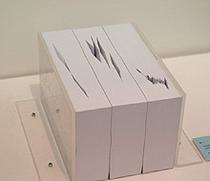 The Glacier Project
The Glacier Project
The second department which for me had a lot to offer was Communication Art & Design. It’s graphic arts and design, but with a very broad approach and one that really succeeds in transgressing into other media and disciplines such as research. Elisabeth Jackson‘s “Glacier Project” was a good example for that. It is “a response to field trips in the French Alps and research into the science of glaciology.” It “moves away from the conventions of encyclopaedic knowledge; facts are given space to breathe.” Practically this means that she used paper as a material to approach the materiality of her subject and conduct several “studies”. Colors of blue, sides of books in which crevasses appear or – almost surreally beautiful – 465 pages of different papers which bound together form a layer of snow.
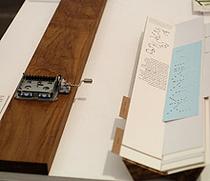
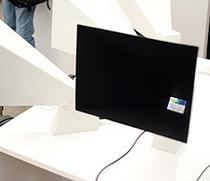 Rosanna Traina and Quentin Walesch went for an audio-visual approach. While she combined a tiny punch-card operated organ with storytelling, Quentin collaborated with sound artist Stephen Lumenta to create horn-shaped viewing/listening posts for their pieces.
Rosanna Traina and Quentin Walesch went for an audio-visual approach. While she combined a tiny punch-card operated organ with storytelling, Quentin collaborated with sound artist Stephen Lumenta to create horn-shaped viewing/listening posts for their pieces.
Many more pictures to be found here.
